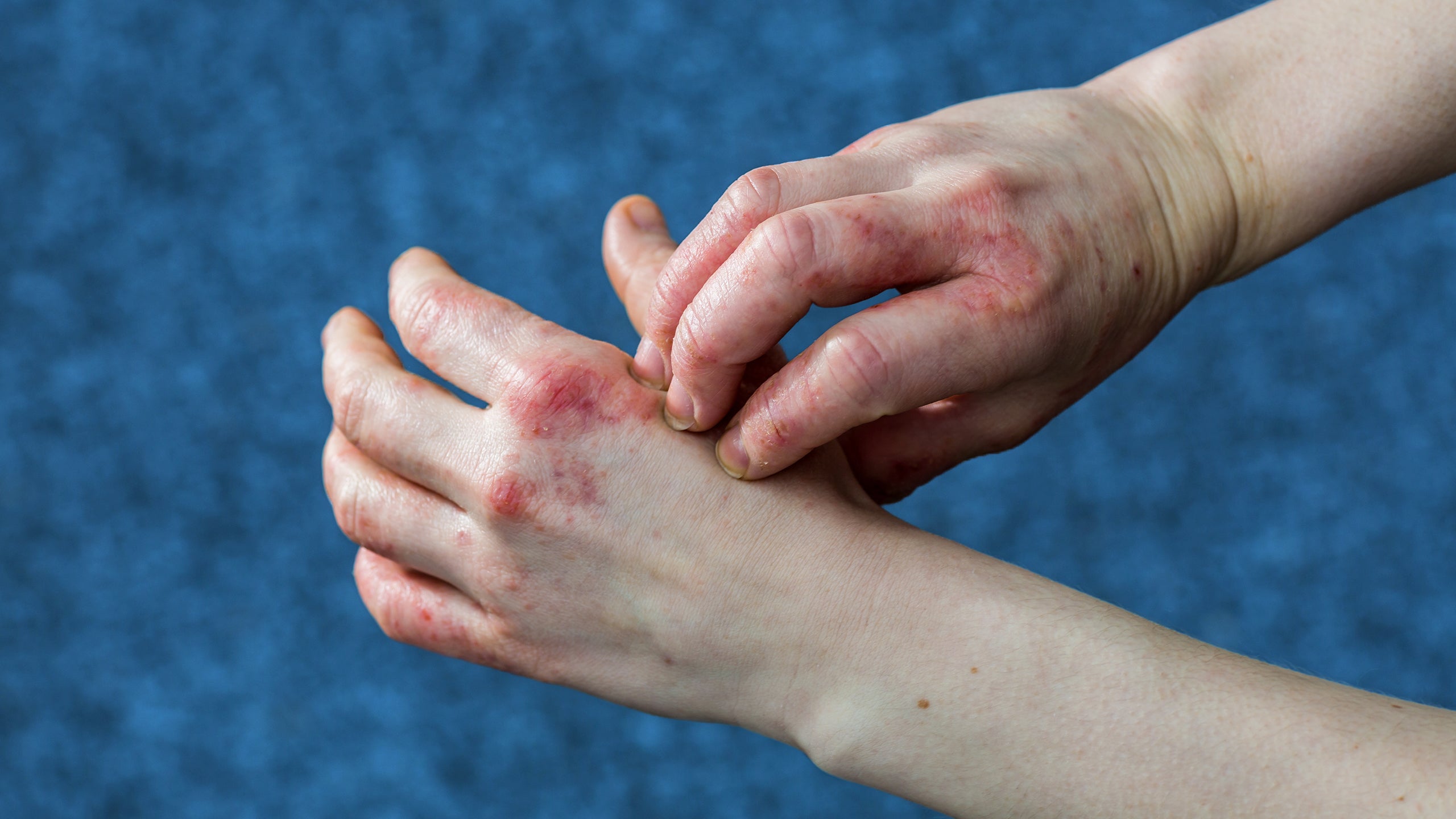Dyshidrotic eczema is a type of eczema (dermatitis) that causes blisters on the hands and feet. It is also sometimes called pompholyx, foot-and-hand eczema, palmoplantar eczema, or vesicular eczema.
The blisters characteristic of dyshidrotic eczema are often intensely itchy and can be either acute, recurrent, or chronic. It is most common in women and adults under 40.
Learn everything you need to know about dyshidrotic eczema symptoms, causes, and treatment.
Dyshidrotic Eczema Symptoms
Dyshidrotic eczema flares occur on the palms of the hands, sides of the fingers, soles of the feet, and toes. They typically involve:
- Itching, burning, prickling, or pain
- Small, fluid-filled blisters (called vesicles); blisters may sometimes grow together and form larger blisters
- Red, peeling skin after blisters heal
Other potential symptoms of dyshidrotic eczema include dark spots (especially on darker skin tones) and, for people with recurring or long-standing dyshidrotic eczema flare-ups, the development of pits, ridges, and discoloration in the nails.
Even mild to moderate dyshidrotic eczema symptoms can be challenge and impact social interactions and the ability to work. You can read more about these issues in our articles on hand eczema at work, eczema at school, and when eczema is classified as a disability.
Dyshidrotic eczema pictures
If you’re wondering, “what does dyshidrotic eczema look like?” keep in mind that eczema’s appearance varies from person to person and looks different on different skin tones. Here are a few example pictures of dyshidrotic eczema.

Dyshidrotic eczema on back of hands

Dyshidrotic eczema on side of finger
 Dyshidrotic eczema on palm of hand & fingers
Dyshidrotic eczema on palm of hand & fingers
Dyshidrotic Eczema Causes
The exact cause of dyshidrotic eczema — and all other types of eczema — remains unknown. Potential triggers (not causes) include nickel, stress, hay fever, hot and humid weather, and sweaty palms. Dyshidrotic eczema runs in families, which indicates genetics may play a role in its development.
Dyshidrotic Eczema Treatment
There is no cure for dyshidrotic eczema, but you can treat your skin to help manage symptoms and prevent future flare-ups. Here are four ways to help improve the health of your skin and get you back to feeling comfortable…and not so itchy!
1. Apply a Cold Compress
Scratching itchy blisters will only make your dyshidrotic eczema worse. Broken skin increases your risk of infection and slows down healing.
That’s why it’s crucial to take action to reduce itching. Many people who have eczema find that applying a cold compress can help reduce itch.
To create a cold compress, run a washcloth under cold water until moistened. Remove any excess water, and apply the homemade compress to your eczema patch. You can repeat this process as often throughout the day as needed.
2. Moisturize with Gentle Skincare Products
Moisturizing the skin after cleansing is an important part of managing dyshidrotic eczema and other forms of eczema. Our hands are busy throughout the day, which can exacerbate dyshidrotic eczema symptoms. Moisturizing frequently can go a long way!
Ingredients like glycerin used in moisturizers strengthen the skin barrier and help it retain moisture. Be sure to choose a moisturizer that’s fragrance-free, minimally formulated, and built with your skin in mind.
3. Avoid Triggers
Nickel, stress, hay fever, and hot and humid weather are all potential dyshidrotic eczema triggers. Avoiding these environmental factors and irritants likely won’t cause your dyshidrotic eczema to disappear completely, but minimizing these triggers should help lessen flare-ups and make management easier.
You can’t avoid triggers altogether, but do what you can to:
- Steer clear of jewelry that contains nickel or cobalt
- Rinse off sweat and stay cool in warm weather
- Minimize stress through stress management techniques and lifestyle adjustments
- Manage seasonal allergies
4. Consult Your Dermatologist
If the blisters on your hands and/or feet get worse or aren’t going away, contact your dermatologist or primary healthcare provider. Your dermatologist can evaluate your skin and recommend a personalized treatment plan
To help treat your dyshidrotic eczema, a dermatologist may recommend the use of
- A topical corticosteroid
- Antihistamines to help with the itch and reduce scratching that can make the skin condition worse
If you’re considering corticosteroids (a.k.a steroid creams), remember the possible unwanted effects of overusing steroids, including topical steroid withdrawal. Knowing the benefits and potential side effects of each option you’re considering will help you manage your skin health in the way that's best for you.
You can get the most out of your visit with our guide to how to prepare for your eczema dermatology appointment.
Restore Microbiome Balance and Reduce Eczema Symptoms with Gladskin's Eczema Cream with Micreobalance®
Trillions of bacteria, fungi, and viruses live on your skin’s surface. They make up what’s called your skin microbiome, also known as the skin flora or microbiota. When in balance, these microorganisms live peacefully on the skin and even work together to protect your body from outside environmental threats.
However, when the ratio of good and bad bacteria in the skin microbiome becomes unbalanced, eczema can develop or flare. That’s why keeping these bacteria in their ideal ratio is so important.
Even though an imbalance in the skin microbiome can contribute to, cause, and worsen eczema flare-ups, most products available today fail to address it. That’s why we created Gladskin Eczema Cream with Micreobalance® to restore balance to your skin microbiome while moisturizing. It’s clinically proven to reduce eczema symptoms, steroid-free, and minimally formulated with your skin in mind.
